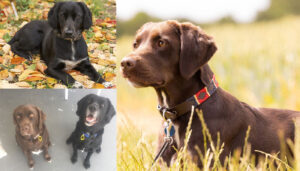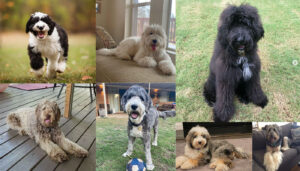
Dogs are remarkable communicators. While they may not speak our language, they excel at conveying their feelings, thoughts, and intentions through their body language. As responsible pet owners, understanding and interpreting your dog’s body language is crucial for fostering a deeper bond and ensuring their well-being. So, let’s delve into the fascinating world of canine communication and decode what your furry friend is trying to tell you.
1. The Importance of Body Language
Understanding the importance of body language in dogs is fundamental for any pet owner. Dogs, like humans, communicate through a variety of channels, but their primary form of expression is through body language. Here’s an in-depth exploration of why body language matters so much for dogs and their human companions:
1.1. Natural Form of Expression:
Body language is inherent to dogs and is deeply ingrained in their instincts and behavior. From the moment they are born, dogs use body language to communicate with their littermates, mother, and other dogs in their environment. This natural form of expression allows them to convey a wide range of emotions, needs, and intentions without the need for vocalizations.
1.2. Nuanced Communication:
Every movement and gesture in a dog’s body language carries significance. From the way they hold their ears to the position of their tail, dogs convey subtle nuances in their emotional state and intentions. For example, a slight tilt of the head may indicate curiosity or attentiveness, while a stiff posture may signal tension or aggression. By paying attention to these cues, you can gain valuable insights into your dog’s feelings and respond appropriately.
1.3. Emotional State:
Body language serves as a window into a dog’s emotional state. Whether they’re feeling happy, anxious, excited, fearful, or relaxed, dogs express their emotions through their body movements. For instance, a wagging tail may indicate happiness or excitement, while trembling or cowering may suggest fear or anxiety. Understanding these cues allows you to assess your dog’s emotional well-being and provide the necessary support and reassurance.
1.4. Social Interaction:
Body language plays a crucial role in dogs’ social interactions with other dogs and humans. Dogs use body language to establish and maintain social hierarchies, communicate their intentions during play, and navigate social situations. For example, a submissive dog may lower their body and avoid direct eye contact with a more dominant dog as a sign of deference. Similarly, dogs use body language cues to signal their intentions and boundaries during interactions with humans.
1.5. Relationship Building:
Paying attention to your dog’s body language is essential for building a strong and trusting relationship. By understanding their cues and responding appropriately, you can demonstrate empathy, respect, and attentiveness to your dog’s needs. This, in turn, fosters a deeper bond based on mutual understanding and communication.
2. Key Elements of Canine Body Language
Understanding canine body language is essential for any dog owner. Dogs communicate primarily through their body movements, and interpreting these signals accurately can help you better understand your furry friend’s emotions and needs. Here are the key elements of canine body language explained in detail:
2.1. Tail Wagging:
Contrary to popular belief, a wagging tail doesn’t always indicate a happy dog. The speed, height, and direction of the wag can convey different emotions:
- High, Fast Wag: Often indicates excitement or agitation. This could be triggered by seeing a beloved human, another dog, or anticipating something enjoyable like a walk or playtime.
- Slow, Low Wag: May signal insecurity or fear. If a dog is feeling anxious or unsure in a new environment or situation, their tail might wag slowly and close to their body.
2.2. Ear Position:
A dog’s ear position can reveal a lot about their emotional state:
- Ears Held Forward: Suggest attentiveness or curiosity. When a dog is interested in something, their ears may perk up and point forward, indicating that they are alert and engaged.
- Flattened Ears: Indicate fear, anxiety, or submission. Dogs may flatten their ears against their head when they feel threatened or intimidated, signaling that they are trying to appear smaller and less threatening.
- Erect Ears: Typically signify alertness or aggression. When a dog’s ears are erect and facing forward, it suggests that they are on high alert and may be prepared to defend themselves or their territory.
2.3. Eye Contact:
Eye contact is a powerful form of communication for dogs:
- Direct Eye Contact: Can be interpreted as a challenge or a sign of trust, depending on the context. In some situations, direct eye contact may be perceived as a threat, especially if accompanied by other aggressive body language. However, sustained eye contact with soft eyes can convey trust and affection.
- Relaxed Gaze with Soft Eyes: Indicates comfort and relaxation. When a dog feels safe and secure, they may maintain eye contact with a relaxed expression and soft eyes, demonstrating their trust and affection for their owner.
- Hard Stare: May denote aggression or defensiveness. A dog staring intensely with a rigid posture and tense facial expression may be signaling that they feel threatened or challenged and are prepared to defend themselves.
2.4. Body Posture:
A dog’s overall posture provides valuable insights into their mood:
- Relaxed, Loose Stance with a Slightly Wagging Tail: Suggests contentment and relaxation. A dog who is comfortable in their environment will typically have a loose, relaxed posture, with their weight evenly distributed and a gently wagging tail.
- Stiff, Rigid Body Language: May signal tension or aggression. When a dog feels threatened or uncomfortable, they may tense up their muscles and hold their body stiffly, indicating that they are prepared to react defensively if necessary.
2.5. Facial Expressions:
Dogs can convey a wide range of emotions through facial expressions:
- Relaxed, Open Mouth with a Slightly Lolling Tongue: Indicates a calm and friendly demeanor. A dog with a relaxed mouth and slightly protruding tongue is likely feeling comfortable and at ease in their surroundings.
- Bared Teeth, Wrinkled Muzzle, or a Furrowed Brow: Signal discomfort or aggression. These facial expressions are often accompanied by other aggressive body language cues, such as stiff posture and direct eye contact, indicating that the dog may be feeling threatened or defensive.
Understanding these key elements of canine body language can help you communicate more effectively with your dog and strengthen your bond with them. By paying attention to their tail wagging, ear position, eye contact, body posture, and facial expressions, you can gain valuable insights into your dog’s emotions and respond appropriately to their needs. This mutual understanding and communication are essential for building a trusting and harmonious relationship between you and your furry companion.
3. Signs of Stress or Anxiety
Recognizing signs of stress or anxiety in your dog is crucial for their well-being and overall happiness. Dogs, like humans, can experience a range of emotions, including stress and anxiety, and it’s essential to be attentive to their signals to address any underlying issues promptly. Here are some common indicators of stress or anxiety in dogs, along with ways to alleviate their discomfort and create a more supportive environment:
3.1. Excessive Panting:
While dogs pant to regulate their body temperature, excessive panting can be a sign of stress or anxiety. If your dog is panting heavily in a situation where they are not overly hot or exerting themselves, it may indicate that they are feeling anxious or uncomfortable.
3.2. Drooling:
Excessive drooling, especially when accompanied by other signs of stress, can indicate that your dog is feeling anxious or nervous. Pay attention to situations or environments that trigger this response in your dog and try to alleviate their discomfort.
3.3. Pacing:
If your dog is pacing back and forth, it may be a sign that they are feeling restless or anxious. Dogs may pace when they are stressed or anxious about a particular situation, such as being left alone or encountering unfamiliar people or animals.
3.4. Yawning:
While yawning is a normal behavior for dogs, excessive yawning, especially in stressful situations, can be a sign of anxiety. Dogs may yawn as a way to relieve tension or communicate their discomfort.
3.5. Lip Licking:
Lip licking can be a subtle sign of stress or anxiety in dogs. If you notice your dog licking their lips frequently, especially in situations that make them feel uneasy, it may indicate that they are feeling stressed or nervous.
3.6. Avoidance Behavior:
Some dogs may exhibit avoidance behavior when they are feeling stressed or anxious. This can include avoiding eye contact, turning away from people or other animals, or trying to escape from a stressful situation.
Alleviating Your Dog’s Discomfort:
Once you recognize signs of stress or anxiety in your dog, there are several steps you can take to alleviate their discomfort and create a more supportive environment:
- Identify Triggers: Pay attention to situations or environments that trigger stress or anxiety in your dog and try to minimize their exposure to these triggers when possible.
- Provide Comfort: Offer your dog a safe and comfortable space where they can retreat when they are feeling stressed or anxious. This could be a cozy bed in a quiet room or a familiar crate.
- Use Positive Reinforcement: Use positive reinforcement techniques, such as praise, treats, or favorite toys, to help your dog associate stressful situations with positive experiences.
- Seek Professional Help: If your dog’s stress or anxiety persists despite your efforts to alleviate it, consider seeking guidance from a professional dog trainer or behaviorist who can provide personalized advice and support.
By recognizing signs of stress or anxiety in your dog and taking steps to address their discomfort, you can help them feel more relaxed, secure, and confident in their environment. Creating a supportive and nurturing environment for your dog is essential for their overall well-being and happiness.
4. Tailoring Your Approach
Tailoring your approach to your dog is essential for building a strong bond and fostering a harmonious relationship. Every dog is unique, with its own personality, preferences, and quirks. Therefore, it’s crucial to observe and learn your dog’s individual body language cues to understand their needs and communicate effectively. Here’s a detailed look at how to tailor your approach to your dog:
4.1. Observation:
Begin by observing your dog’s behavior in different situations and environments. Pay attention to how they interact with people, other animals, and their surroundings. Notice their body language, including their tail wagging, ear position, eye contact, and overall posture.
4.2. Learn Their Cues:
Once you’ve observed your dog’s behavior, take the time to learn their unique body language cues. Dogs communicate primarily through their body movements, so understanding their signals is key to interpreting their feelings and intentions. For example, you might notice that your dog’s tail wags more vigorously when they’re excited about going for a walk, or they may lower their ears when they’re feeling anxious in a crowded environment.
4.3. Adjust Your Interactions:
Based on your observations and understanding of your dog’s cues, adjust your interactions accordingly. For example, if you notice that your dog becomes nervous or agitated when approached by strangers, you can help them feel more comfortable by giving them space and allowing them to approach new people at their own pace.
4.4. Respect Their Boundaries:
Respecting your dog’s boundaries is essential for building trust and mutual respect. Pay attention to signs of discomfort or stress, such as lip licking, yawning, or avoidance behavior, and avoid putting your dog in situations where they feel overwhelmed or anxious. Allow them to retreat to a safe space if they need a break, and never force them into interactions that make them uncomfortable.
4.5. Prioritize Their Comfort and Well-being:
Above all, prioritize your dog’s comfort and well-being in all interactions and activities. This means providing them with a safe and stimulating environment, meeting their physical and emotional needs, and ensuring they have plenty of opportunities for exercise, mental stimulation, and socialization.
By tailoring your approach to your dog and paying attention to their individual needs and preferences, you can strengthen your bond and create a supportive and nurturing relationship based on trust and understanding. Remember that building a strong relationship with your dog takes time, patience, and empathy, but the rewards are well worth the effort.
5. Building Trust and Connection
Building trust and connection with your dog is essential for a fulfilling and harmonious relationship. Dogs are highly attuned to human emotions and respond positively to caregivers who understand and empathize with their needs. By becoming fluent in your dog’s body language, you can strengthen the bond between you and your furry companion. Here’s a detailed look at how to build trust and connection with your dog:
5.1. Understanding Body Language:
Start by learning to interpret your dog’s body language cues. Pay attention to their tail wagging, ear position, eye contact, facial expressions, and overall posture. These signals provide valuable insights into your dog’s emotions, needs, and intentions. By understanding their body language, you can communicate more effectively and respond appropriately to their cues.
5.2. Empathy and Compassion:
Cultivate empathy and compassion towards your dog. Put yourself in their paws and try to see the world from their perspective. Recognize that they have their own unique personalities, fears, and preferences. Approach interactions with kindness and understanding, and always prioritize their comfort and well-being.
5.3. Consistency and Predictability:
Dogs thrive on routine and predictability. Establish consistent daily routines for feeding, exercise, and training. Consistency helps your dog feel secure and confident, knowing what to expect from their environment and caregivers. Avoid sudden changes or disruptions to their routine whenever possible.
5.4. Positive Reinforcement:
Use positive reinforcement techniques to reinforce desired behaviors and build trust with your dog. Reward them with treats, praise, and affection when they exhibit behaviors you want to encourage. Positive reinforcement creates a positive association with you as their caregiver and strengthens the bond between you.
5.5. Quality Time Together:
Spend quality time bonding with your dog through activities they enjoy. Whether it’s going for walks, playing games, or simply cuddling on the couch, invest time in building positive experiences together. Engage in activities that strengthen your connection and deepen your bond.
5.6. Communication and Listening:
Communication is a two-way street. Listen to your dog and respond to their needs and cues accordingly. Pay attention to how they communicate with you, whether it’s through vocalizations, body language, or behavior. By listening attentively and responding with empathy, you demonstrate that you value and respect their communication efforts.
5.7. Patience and Understanding:
Building trust and connection takes time and patience. Be patient with your dog as they learn and grow, and understand that building a strong bond is a journey rather than a destination. Celebrate progress, no matter how small, and approach challenges with a positive attitude and a willingness to learn together.
Conclusion
Understanding canine body language is an invaluable skill for any dog owner. By learning to interpret your dog’s signals accurately, you can enhance communication, strengthen your bond, and ensure a happy, fulfilling relationship for both you and your beloved pet. So, the next time your dog wags its tail or cocks its head, take a moment to listen and respond with understanding. Your furry friend will thank you for it.
 Introducing Shug: The German Shepherd & Pug Mix
Introducing Shug: The German Shepherd & Pug Mix Borador: A Perfect Mix of Labrador Retriever and Border Collie
Borador: A Perfect Mix of Labrador Retriever and Border Collie Chi-Poo Dog Breed: A Perfect Blend of Poodle and Chihuahua Traits
Chi-Poo Dog Breed: A Perfect Blend of Poodle and Chihuahua Traits Springador Dog: Discover the Perfect Blend of Labrador Retriever and English Springer Spaniel
Springador Dog: Discover the Perfect Blend of Labrador Retriever and English Springer Spaniel The Bulldog: A Tenacious and Endearing Companion
The Bulldog: A Tenacious and Endearing Companion Discover the Charming Sheepadoodle: Poodle + Old English Sheepdog Mix
Discover the Charming Sheepadoodle: Poodle + Old English Sheepdog Mix Shepadoodle: A Perfect Blend of German Shepherd and Poodle Traits
Shepadoodle: A Perfect Blend of German Shepherd and Poodle Traits The Goldador: Where Labrador and Golden Retriever Meet
The Goldador: Where Labrador and Golden Retriever Meet The Sheprador: A Loyal and Energetic Blend of Intelligence and Affection
The Sheprador: A Loyal and Energetic Blend of Intelligence and Affection Maltipoo: The Perfect Blend of Poodle and Maltese
Maltipoo: The Perfect Blend of Poodle and Maltese Golden Retrievers: The Heartwarming Companions You’ll Never Forget
Golden Retrievers: The Heartwarming Companions You’ll Never Forget The French Bulldog: A Delightful Charmer with Endless Personality
The French Bulldog: A Delightful Charmer with Endless Personality